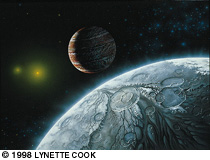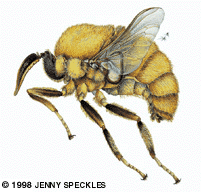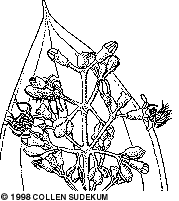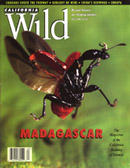|
CURRENT ISSUE
SUBSCRIBE
CONTACT US
ADVERTISING
SEARCH
BACK ISSUES
CONTRIBUTORS'
GUIDELINES
THIS WEEK IN
CALIFORNIA WILD
|
Here at
the academy
The Art of Science
Gordy Slack
The notorious rift between art and science is bridged
in Norman Penny's office. There, on almost any day of the week, one of
a half-dozen artists is likely to be sitting with a rapidograph in one
hand and the focus knob of a microscope in the other. From their pens
slowly emerge the excruciatingly delicate patterns of insects' wings.
Nothing is more important here than the illustration's accuracy. But when
accuracy is achieved, beauty nearly always is, too. Penny,
the Department of Entomology's collections manager, describes the illustrators
as angels, doing work absolutely fundamental to the Academy's scientific
mission, but often devoting their time for no pay.
Hundreds of able illustrators have passed through
the Academy's scientific departments over the years. On these pages
is a selection of work by a few of those working here today.
Lynette Cook
Lynette Cook is one of the nation's foremost
astronomical illustrators. Whereas no speculation is allowed when illustrating
a new species of fish, say, there is a great deal of interpretive latitude
when illustrating an entity known only by indirect means, such as this
extrasolar planet. "I like the balance between creativity and scientific
accuracy," says Cook.
 |
| Emerging from shadow, the newly discovered
exosolar planet around star 16 Cygni B is depicted with a hypothetical
moon bearing polar ice caps, ancient river channels, and more recent
impact craters. |
Jenny Speckles
"There is an incredible variety of
forms, even where I thought only one category existed before,"
Jenny Speckles says. Looking at her flies, I see what she means. Each
one has its own character. Speckles illustrates both for the botany
and entomology departments. "The drawings are objective on some
level," she says, "but there is always the technique which,
no matter what, expresses something of the illustrator's personality.
 Male
fly, Exetasis eickstedtae, mixed media, illustrated for Academy
research associate Evert Schlinger. Male
fly, Exetasis eickstedtae, mixed media, illustrated for Academy
research associate Evert Schlinger.
Colleen Sudekum
For four years Colleen Sudekum
has been working with curator Wojciech Pulawski on his monograph on
African Tachysphex wasps. Unlike most of the Academy's illustrators,
she works strictly on the computer. "With the computer you don't
have to worry about your hand shaking," she says. Computers have
cut the time it takes for her to do an illustration in half. "I
miss the pen, though. I miss the old materials."

Botanical plate of Miconia dodecandra,
pen and ink, illustrated for Frank Almeda by Colleen Sudekum.
Gordy Slack is an Associate Editor
at California Wild. |

Fall 1998
Vol. 51:4
|

